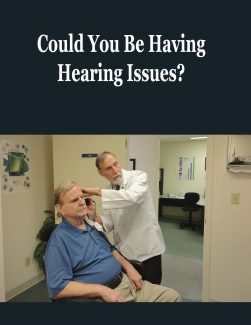
 License Type: Private Label Rights
License Type: Private Label Rights  File Type: ZIP
File Type: ZIP
 SKU: 63755
SKU: 63755  Shipping: Online Download
Shipping: Online Download
Sample Content Preview
Could You Be Having Hearing Trouble?
Around 45 million Americans have some degree of hearing loss. While seniors are the group most at risk (half of people over 75 have some hearing loss), hearing loss can happen to anyone, at any age.
Common reasons for hearing loss include genetics, exposure to loud noise, viruses and infections, as well as blockages and obstructions in the ear from fluid, earwax, or foreign objects. Many forms of hearing loss are preventable but irreversible, so it’s important to take steps to protect your hearing. Read on to learn more about how the ear works, and how common problems can affect your hearing.
=> How the Ear Works
In order to understand how many ear problems develop, it’s helpful to know a little bit about how the ear works. The ear is made up of three parts: the outer, middle and inner ear.
The Outer Ear
The outer ear consists of the ear canal and the pinna (also called the auricle), which is the portion of the ear outside your body. The outer ear captures sound waves and funnels them through the ear canal to the middle ear.
The Middle Ear
The middle ear, an air-filled cavity, has the important job of transforming sound waves into vibrations. Between the outer ear and the middle ear lies the eardrum (tympanic membrane), which stretches tight across the ear canal. When soundwaves come into the ear canal, they hit the eardrum, causing it to move. When the eardrum moves, it sends vibrations into three tiny bones in the middle ear. These bones, the malleus, incus, and stapes (the smallest bone in the body), are collectively called the ossicles. The ossicles transmit vibrations to the inner ear.
In order for the middle ear to work properly, the air pressure on both sides of the body needs to be equal. The Eustachian tubes, which connect the ear to the back of the throat, help to balance pressure on both sides of the body. When you have a bad cold, the Eustachian tubes have a hard time draining fluid and balancing pressure, which is why your hearing can be muffled when you are sick.
The Inner Ear
In the inner ear, the vibrations from the middle ear are transformed into nerve signals that are sent to the brain for processing. The cochlea, a snail-shaped, fluid-filled part of the inner ear, is where vibrations are changed into nerve signals. The nerve signals then travel to the brain along the cochlear nerve.
Just above the cochlea, like antennae on a snail, are the semicircular canals. These three fluid-filled tubes control balance. Each canal is lined with tiny hairs. As you move, the fluid in the tubes splashes around, moving the tiny hairs. This provides information on the position of the body. The hairs send that data to the brain via the vestibular nerve. The brain then sends signals to our muscles, helping us to stay balanced.
If you are prone to motion sickness, you have the semicircular canals to thank. When they sense a lot of movement, but the eyes say we’re staying still (as on an airplane), the brain gets confused, resulting in nausea.
Hearing Loss
Hearing loss is classified into three types, depending on where in the ear the problem originates.
* Conductive hearing loss involves the outer or middle ear. In conductive hearing loss, something is preventing the sound waves from reaching the inner ear. The most common causes of conductive hearing loss are blockages from fluid, earwax or foreign objects in the ear, and ear infections.
* Sensorineural hearing loss involves the inner ear. Sensorineural hearing loss is most commonly caused by genetics, viruses and infections, exposure to loud noises, and as a side effect of some medications and other chemicals.
* Mixed hearing loss occurs when there is both conductive hearing loss and sensorineural hearing loss. Mixed hearing loss can happen as the result of a head injury, infections, or due to genetic disorders.
While some types of conductive hearing loss can be reversed, many forms of sensorineural hearing loss can’t be improved. However, if your hearing loss can’t be reversed, doctors and audiologists have many tools to help you manage hearing loss, including hearing aids, surgery, and training on how to minimize the impact of hearing loss on your life.
=> Protecting Your Ears from Hearing Loss
While you can’t do anything about your genetics, you can protect your ears from some kinds of hearing loss. Even if you already have some amount of hearing loss, protecting your ears will help prevent future damage, and keep your hearing as healthy as possible.
- License: Private Label Rights
- Category:Ebooks
- Tags:2021 Ebooks Private Label Rights







